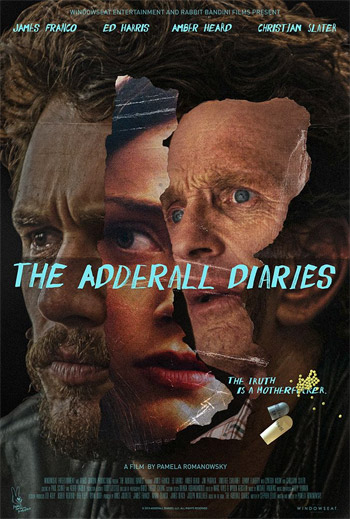
It’s safe to assume that James Franco loves literary adaptations. The Adderall Diaries is based on a memoir of the same name by Stephen Elliot. Franco played Stephen, a writer who seems to be at the height of his career. His agent constantly calls him about various book deals and options. There’s even a new romance in the air, as he met a pretty reporter from the Times (Amber Heard) during a high-profile murder trial. Yet he’s still haunted by the ghost of his traumatic past, especially his *monster* dad who through a series of flashbacks seems like a beligerent and abusive father Neil who made his childhood a living hell. During a reading of his memoir, Neil suddenly turned up and confronted his son just as Stephen was reading from his memoir that he was deceased.

Needless to say, Stephen’s life went on a downward spiral as the book deals quickly dried up. He descended into self-destructive behavior with substance abuse (with Adderall tablets being his drug of choice) and BDSM sessions with prostitutes, all the while his daddy-issues overwhelmed him to the point that he alieniated everyone close to him. It’s hard to tell fact from fiction in a blur of drug-induced haze Stephen constantly puts himself under. Therein lies the crux of the story: what is really fact and what is a product of his imagination? The film asks the question of what it means to tell the truth, and how we often choose to see things our own way. In the case of Stephen, all his life he incessantly sees himself as the *victim.*
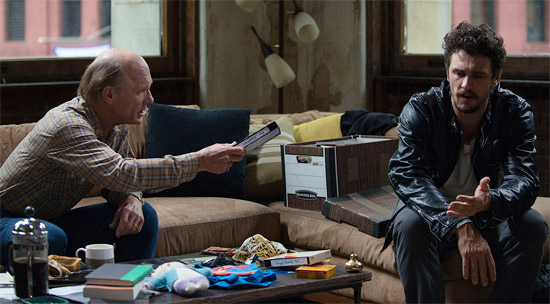
There are a lot going on in this film, but the father/son relationship is central to the story. There’s a facet of crime drama in the murder trial subplot, but it’s always seen through Stephen’s eyes and how those events bring out elements from his own past. I don’t always get what is going on in a particular scene, but the film’s pace and script remains engaging and some of the cryptic moments intrigue instead of frustrate me. Perhaps the fact that writer/diretor Pamela Romanowsky studied behavioral psychology at Macalester College in MN made her the right person to adapt this book.
The performances are ace all around. James Franco delivered a convincing performance as someone who’s totally lost and full of anger. Stephen isn’t exactly a likable character, yet there’s a layered vulnerability and real angst that made me sympathize with him. The always reliable Ed Harris is phenomenal here as Stephen’s estranged dad, the scenes between the two of them are the most intense and emotional parts of the film. The rest of the supporting cast, Amber Heard, Cynthia Nixon, Jim Parrack and Christian Slater are solid as well.
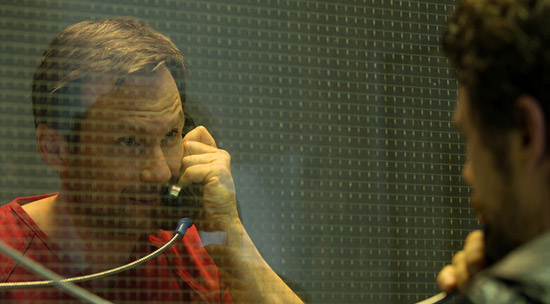
This is a confident directorial debut from Romanowsky. There are quite a few flashback scenes in the film and at times they serve as scenes from the character’s memories. So it’s crucial that the transition isn’t jarring or become too hard to follow. I never felt lost watching the story and that’s a testament to a deft direction. Not only did the story translate well cinematically, she also brought out excellent performances from her actors.
I’m thrilled that Pamela’s next project will be writing and directing Chuck Palahniuk‘s novel Rant: The Oral Biography of Buster Casey. Based on this article, the novel is set in a dystopian future and involves people competing in a secret game of demolition derby, all while the world becomes an even worse place as time passes. James Franco is set to play the title role once again, it definitely sounds intriguing and I can’t wait to see what Pamela will do with that project.
…
TCFF Screening Time(s):
10/29/2015 (7:10 PM)
10/31/2015 (3:00 PM)
I had the privilege of chatting with director Pamela Romanowsky about making the film, working with James Franco & Ed Harris, and the challenges being a female filmmaker in Hollywood.

Q: How did you come on board this project?
I read The Adderall Diaries for the first time as a casual reader. It was in the window at my neighborhood bookstore in Brooklyn (which is where James signs books in the opening scene of the film), and I finished it in a couple days. It really stuck with me, in particular his insights and admissions about how we edit our memories to fit a personal narrative. Some months later in Detroit, James and I were working together on The Color of Time, a multi-director adaptation of CK Williams’ brilliant poetry collection TAR. My vignette is an adaptation of the poem “Tar” and it’s also about how memory affects our experience of the present. James asked me if I would be interested in adapting a book he’d optioned called The Adderall Diaries. Of course I jumped at the opportunity.
Q: What was the challenges of adapting a novel/memoir into a screenplay?
 It’s a different set of challenges for each project. In this case, it was figuring out how to translate the book’s foundational themes and ideas into cinematic language. The form and style of the book is very different from a movie- It’s about moments and impressions more than it is a traditional story with a plot and character arcs. The quote that opens the movie is one I had pinned up on my writing board, which I think is the beating heart and central idea of the book.
It’s a different set of challenges for each project. In this case, it was figuring out how to translate the book’s foundational themes and ideas into cinematic language. The form and style of the book is very different from a movie- It’s about moments and impressions more than it is a traditional story with a plot and character arcs. The quote that opens the movie is one I had pinned up on my writing board, which I think is the beating heart and central idea of the book.
Stephen says, “We understand the world by how we retrieve memories. Re-order information into stories to justify how we feel.” I’m deeply moved by that thought, both the truthfulness of it and his willingness to expose it in himself. We all know memory is an emotionally charged and unreliable thing, and that’s easy to point out as a concept, even easier to point out in another person who has a different version of our story, but few of us have the balls to point to it in ourselves.
The central conflict in the movie is that Stephen and his father Neil have organized the facts of what happened between them into very different stories. Each man has cast himself as the victim, and so he needs the other to admit some culpability so he can be right. In the movie, it takes all these other satellite characters orbiting Stephen (his girlfriend, his best friend, his muse and his editor) to get into conflict with him at the same time, before it finally clicks that if everyone edits their memory to validate an emotional position, he’s doing it, too.
It took me two years to get from first draft to the first day on set, and I was re-writing the whole way. The biggest leaps and best insights came out of the work I did with the Sundance Institute, where I was a fellow at the screenwriting, directing and sound/music labs. My experiences there changed not only how I approached this project, but how I approach my job and my voice as a writer and director in general. Michelle Satter, founding director of the feature film program, and Robert Redford, who needs no introduction, were two of my most helpful and primary advocates throughout, reading scripts, watching cuts, and opening doors.
Q: Which do you enjoy most, writing or directing?
Directing. I didn’t know what the job meant until I was in it, and I feel really lucky to have stumbled upon my dream job. It’s the intersection of all of my interests, joys and skills, and it’s never ever the same thing twice. It keeps me constantly on my toes and learning, working with brilliant people. It’s about adjusting, trying to zero in on the thing you want from different approaches (I always think of a GPS saying “re-calculating” over and over again). I love the great leap of faith into intimacy everyone has to take, especially between actors and directors. You expose a lot of yourself working scenes out, whether you talk about it overtly or not. How do you lie? How do you flirt or chase respect? How do you experience regret or sex or losing your temper or ignoring the elephant in the room? It’s all in there, and you get to know and respect each other in really deep ways.
There’s deep beauty and satisfaction in writing, too, but for me it’s much less pleasurable than directing.

Q: You had worked with James Franco before when you did ‘The Color of Time’ while at NYU. How did the rest of the cast come on board this project?
I met James in grad school at NYU where we both did the MFA film program. He’s always felt like a kindred spirit and we became friends right away, but we hadn’t worked together until The Color of Time. We got to bond in a deeper way as collaborators on that film and even more so on Adderall, and he’s become one of my closest and most treasured friends. He’s magnetic and inspiring, and works harder and more passionately than anyone.
Ed Harris was my mentor at the Sundance Director’s lab, which felt like some kind of crazy hand-of-god fate, because I’d written the part for him without ever knowing I’d get the chance to meet him or tell him so. He was advising me the day I shot the workshop version of Stephen and Neil’s climactic scene (with the fantastic actors Luke Kirby and Dennis Boutsikaris), and at one point Ed asked if he could jump in to offer a suggestion. He hugged Luke and then tossed him over the hood of a car, and I just stood there breathlessly, seeing the character I’d imagined for so long come vividly to life. Ed is electric and that’s so exciting to be around.
Jim Parrack (Roger) is one of James’ oldest friends in real life. Their rapport, in all its competitive, loving, intense glory, is very real. My favorite scene to shoot with them was the boxing scene, because they’re trained boxers and they both learned with the great Macka Foley, who was on set, too. That day was all-in and so intense.
Amber Heard (Lana), Christian Slater (Hans), Cynthia Nixon (Jen) and Timothee Chalamet (Teenage Stephen) all came through my friend Danie Streisand, a phenomenal talent agent who I call the secret casting director of this movie. She cared about and got the project like nobody else, and with each of those actors, it was the most obvious match in the world from the moment I got to meet with them. Each actor brings something different to set, and it’s fascinating to watch how those energies intersect and change each other.

Q: Tell me what it’s like working with Franco and Ed Harris, both of whom are committed and versatile actors working today.
Joan Darling, my acting teacher at the Sundance labs, says that a great actor is like a high speed train- even the smallest adjustment at the beginning of a scene will take you in a very different direction by the end. James and Ed are certainly high-speed trains, and it was an absolute honor and joy to work with them. They’re game to experiment, they commit entirely, they’re emotionally rigorous and they’re fiercely allergic to bullshit. Watching how they communicated and reacted to each other within the scenes was stunning. It’s worth noting that Ed and James are both directors as well- They’re smart and generous people by nature, but I think they were particularly attuned to and patient with what I needed technically and camera-wise because they’re clocking my coverage and know to advocate for that last setup we don’t really have time for but will need in the editing room. And they’re both veterans. What they’ve seen on set and in the industry, as actors and directors, is precious insight for a young director to have.
Q: Given that the gender disparity in Hollywood is such a hot topic these days, would you comment a bit about your own experience as a female filmmaker working on your feature debut?
I’m glad that gender disparity in Hollywood is a hot topic. It should be. Four percent of the top one hundred box office films are directed by women. FOUR. Many years, that number has been lower, and the numbers are similar for people of color and other minorities. How can an industry that represents and creates culture not be affected and made toxic by that obvious, shameful degree of discrimination?
The thing is, the difference between my experience as a first time indie filmmaker and a women embarking on a career in Hollywood will be very different. I’m here talking to you, so obviously I’m one of the women who made a debut feature. It was the hardest thing I’ve ever done, but not because I’m a woman. I had the support and respect of everyone I worked with.
After this, my experience will likely change. Women who make good indie first features don’t get asked to make big studio movies like Spiderman or Jurassic Park. But men do get to take that massive leap. The same number of women and men attend prestigious film schools and write good, vetted screenplays. The first hurdle comes with financing and thus making that first feature. Only 25% of American directors at Sundance are women, skewed heavily toward documentaries. But 25% is a hell of a lot more than 4%. The real obstacle for female directors isn’t making the first indie feature, it’s the opportunity to launch from there into Hollywood. And that’s a very old and carefully guarded obstacle to move. I’m still gonna do my damndest to get there, obviously.
I’m one of the Sundance Institute’s Female Filmmaker Initiative fellows this year, and I’m eager to point to Sundance’s rigorous research and their initiatives for change, because it provides a much clearer and more detailed picture than I can.
…
Thanks again Pamela for chatting w/ me last night
prior to the screening. Totally made my day!
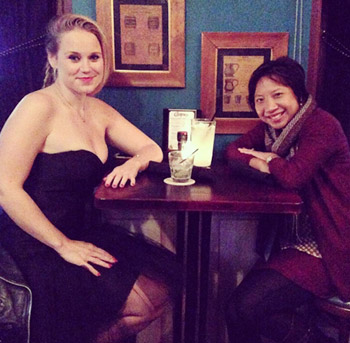
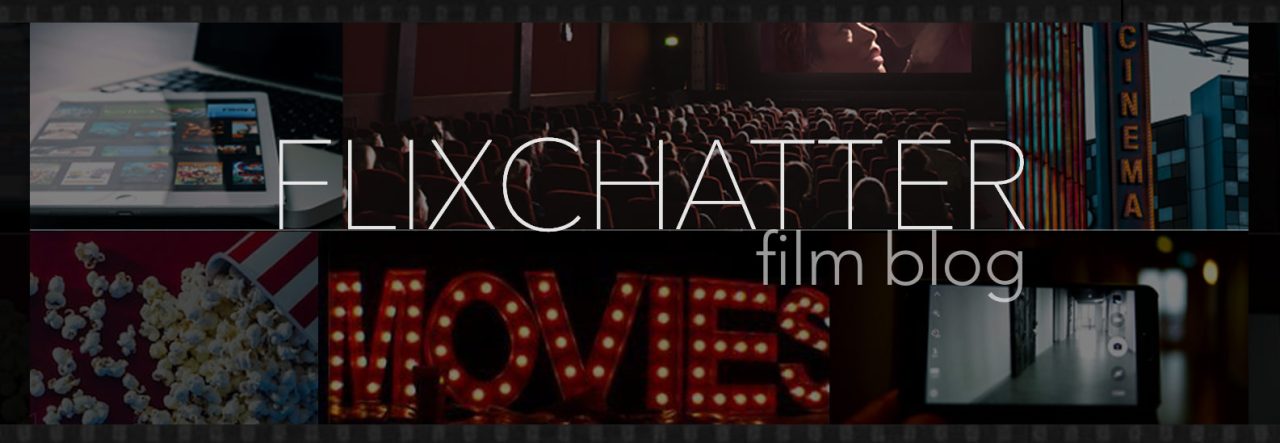
Another James Franco film? LOL. This one looks pretty good, though. 🙂
Pingback: My Top 10 Picks from Twin Cities Film Fest |
Pingback: Counting Down to 2016 Twin Cities Film Fest! Spotlight on indie films I can’t wait to see
Pingback: Spotlight on the eclectic indie films playing at TCFF 2016 - Twin Cities Film Fest
Pingback: A film blogger’s journey into indie filmmaking – writing/producing ‘Hearts Want’ short film – FlixChatter Film Blog